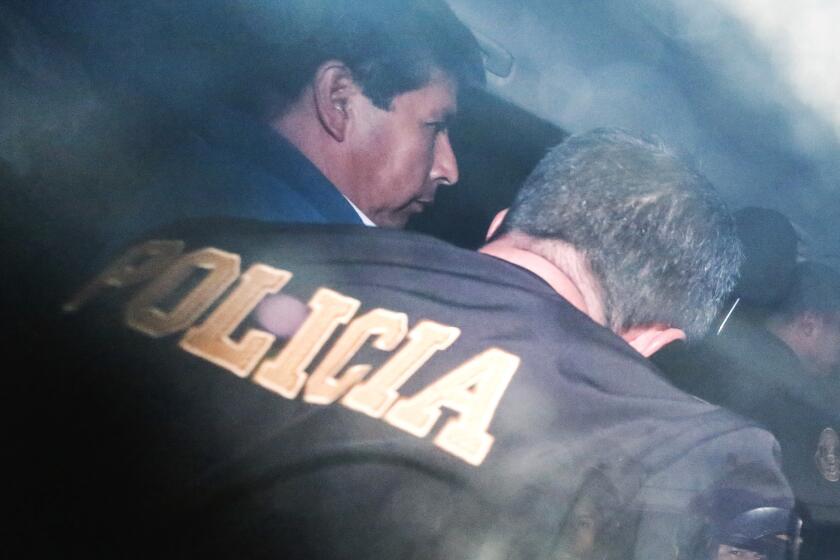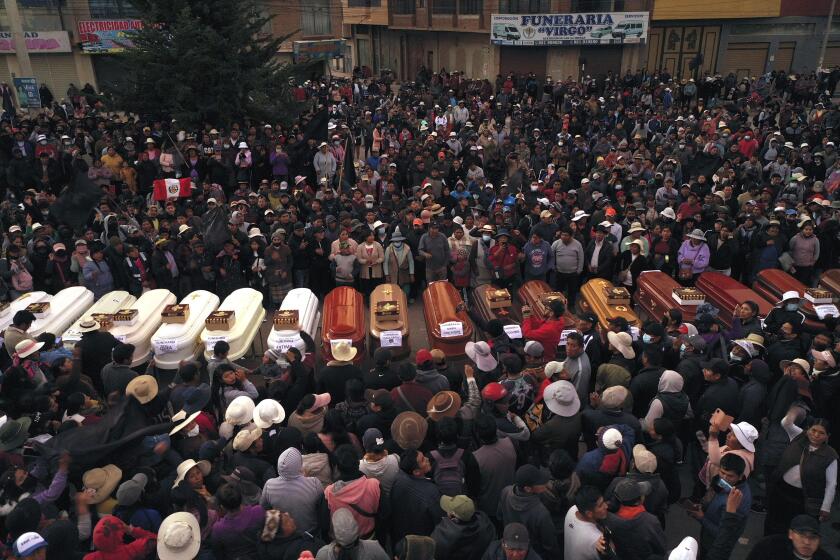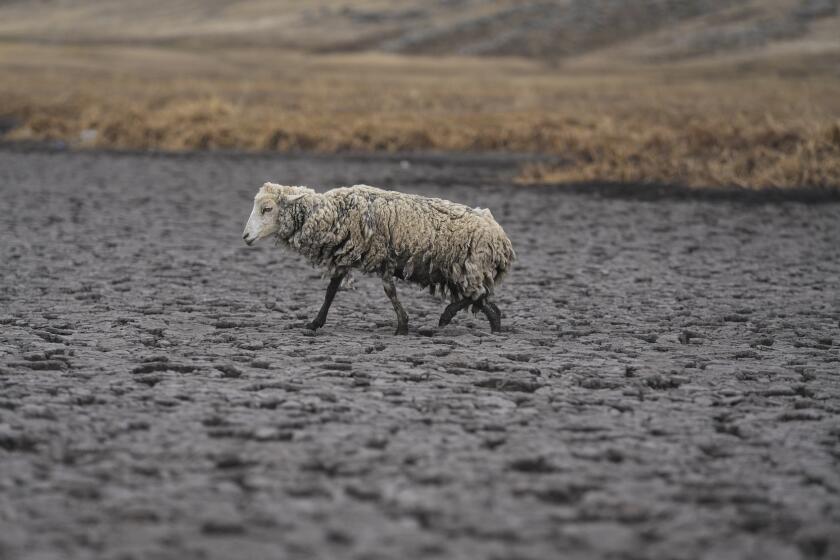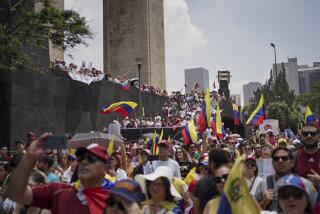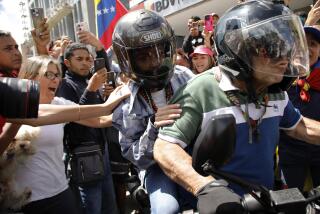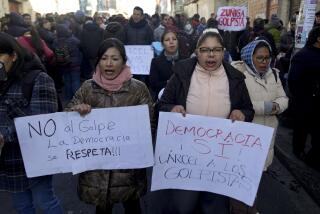Anti-government protesters stream to Peru capital demanding president resigns
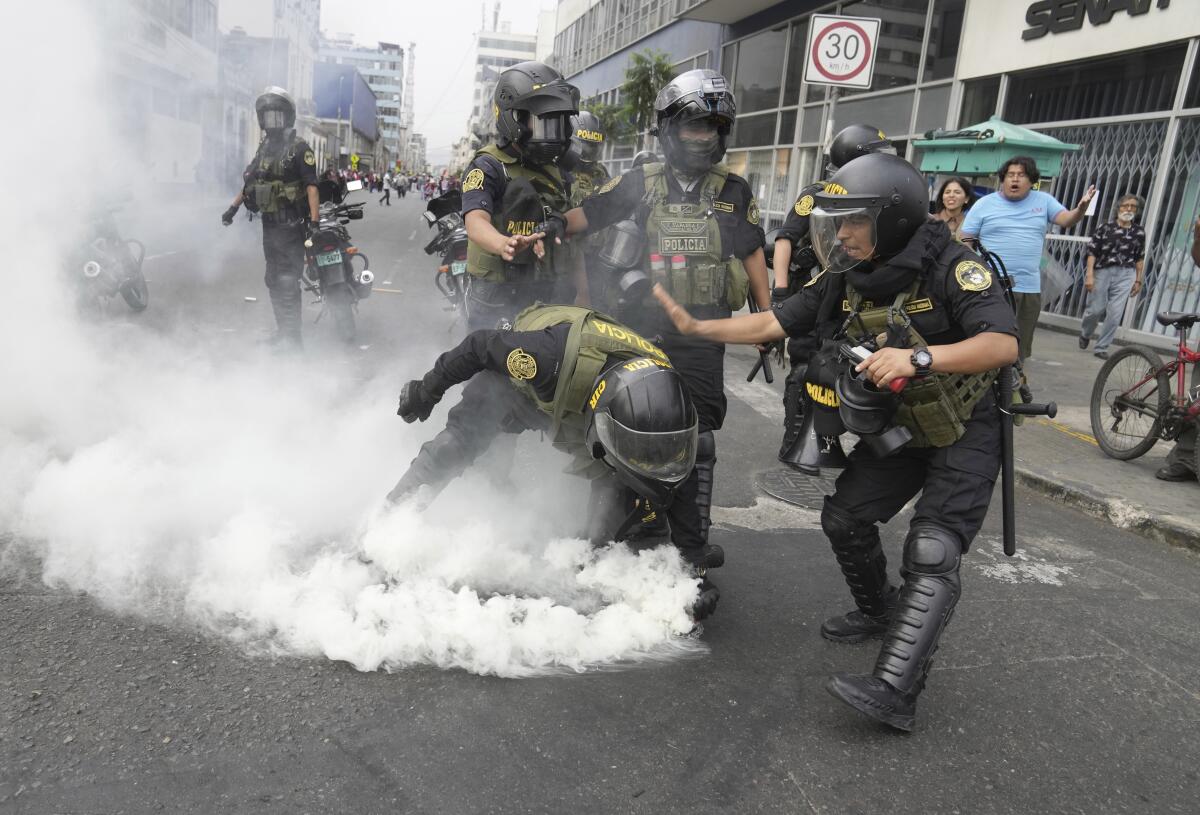
- Share via
LIMA, Peru — Thousands of people poured into Peru’s capital, many from remote Andean regions, for a protest Thursday in opposition to President Dina Boluarte and in support of her predecessor, whose ouster last month launched deadly unrest and cast the nation into political chaos.
Police repeatedly fired tear gas into crowds of demonstrators as night fell, preventing them from heading into business and residential districts of Lima. The supporters of former President Pedro Castillo were demanding Boluarte’s resignation, the dissolution of Congress and immediate elections. Castillo, Peru’s first leader from a rural Andean background, was impeached after a failed attempt to dissolve Congress.
“We have delinquent ministers, presidents that murder, and we live like animals in the middle of so much wealth that they steal from us every day,” Samuel Acero, a farmer who heads up the regional committee of protests for the southeastern city of Cuzco, said as he walked in downtown Lima on Thursday morning. “We want Dina Boluarte to leave; she lied to us.”
Anger at Boluarte was the common thread as street sellers hawked T-shirts saying, “Out, Dina Boluarte,” “Dina murderer, Peru repudiates you,” and a call for “New elections, let them all leave.”
“Our God says thou shalt not kill your neighbor. Dina Boluarte is killing, she’s making brothers fight,” Paulina Consac said as she carried a large Bible while marching in downtown Lima with more than 2,000 protesters from Cuzco.
By early afternoon, protesters had turned key roads into large pedestrian areas downtown.
The protests have so far been held mainly in Peru’s southern Andes, with 54 people dying amid the unrest, most of them killed in clashes with security forces.
“We’re at a breaking point between dictatorship and democracy,” said Pedro Mamani, a student at the National University of San Marcos. Students there are housing demonstrators who traveled for the protest that is being popularly referred to as the “takeover of Lima.”
The university was surrounded by police officers, who also congregated at several key points of Lima’s historic downtown district.
A total of 11,800 police officers will be deployed throughout Lima, Victor Zanabria, the head of the police force there, told local media. He played down the size of the protests, saying he expected around 2,000 people to participate.
While democratic elections are held regularly in Peru, critics say that the results often have more to do with settling scores and politicians getting rich than installing effective governments.
The demonstrations that erupted last month and subsequent clashes with security forces amount to the worst political violence Peru has experienced in more than two decades and has shined a spotlight on the deep divisions between urban elite people, largely concentrated in Lima, and rural poor people.
By bringing the protest to Lima, demonstrators hope to give fresh momentum to the movement that began when Boluarte, who had been vice president, was sworn into office Dec. 7 to replace Castillo.
“When there are tragedies, bloodbaths outside the capital, it doesn’t have the same political relevance in the public agenda than if it took place in the capital,” said Alonso Cárdenas, a professor of public policies at the Antonio Ruiz de Montoya University in Lima. “The leaders have understood that and say, ‘They can massacre us in Cuzco, in Puno, and nothing happens — we need to take the protest to Lima,’” Cárdenas added, naming cities that have seen major violence.
The concentration of protesters in Lima also reflects how the capital has started to see more anti-government demonstrations in recent days.
The protesters Thursday were planning to march from downtown to the Miraflores district, one of the emblematic neighborhoods of the country’s economic elite.
The slaying of an officer on patrol came after the killing of 17 people in Juliaca, Peru, in antigovernment protests that have rocked the country.
The government has called on protesters to be peaceful.
Boluarte has said she supports a plan to move up to 2024 elections for president and Congress, originally scheduled for 2026.
Many protesters insist that no dialogue is possible with a government that they say has unleashed so much violence against its citizens.
Peru’s new government issues a 30-day national emergency declaration suspending the rights of ‘personal security and freedom’ amid violent protests.
As protesters gathered in Lima, more violence erupted in southern Peru.
In the town of Macusani on Wednesday, protesters set fire to the police station and judicial office after three people were killed by gunfire, officials said.
Activists have dubbed Thursday’s demonstration in Lima as the Cuatro Suyos March, a reference to the four cardinal points of the Inca Empire. It’s also the name given to another massive mobilization that took place in 2000, when thousands of Peruvians took to the streets against the autocratic government of Alberto Fujimori, who resigned months later and was later imprisoned for human rights violations.
News Alerts
Get breaking news, investigations, analysis and more signature journalism from the Los Angeles Times in your inbox.
You may occasionally receive promotional content from the Los Angeles Times.
There are several key differences between those demonstrations and this week’s protests.
“In 2000, the people protested against a regime that was already consolidated in power,” Cárdenas said. “In this case, they’re standing up to a government that has only been in power for a month and is incredibly fragile.”
Another distinction is that the 2000 protests had a centralized leadership and were led by political parties.
The protests that have engulfed much of Peru in the last month have largely been grassroots efforts without a clear leadership.
Peru’s small and now dried-up Cconchaccota lagoon is key to survival for people in the area, who rely on the water for their potato crops and livestock.
“We have never seen a mobilization of this magnitude. There’s already a thought installed in the peripheries that it is necessary, urgent to transform everything,” said Gustavo Montoya, a historian at the National University of San Marcos. “I have the feeling that we’re witnessing a historic shift.”
The protests have grown to such a degree that demonstrators are unlikely to be satisfied with Boluarte’s resignation and are now demanding more fundamental structural reform.
The uprising emerged “in regions that have been systematically treated as second-class citizens,” Montoya said. “I think this will only keep growing.”
More to Read
Sign up for Essential California
The most important California stories and recommendations in your inbox every morning.
You may occasionally receive promotional content from the Los Angeles Times.
